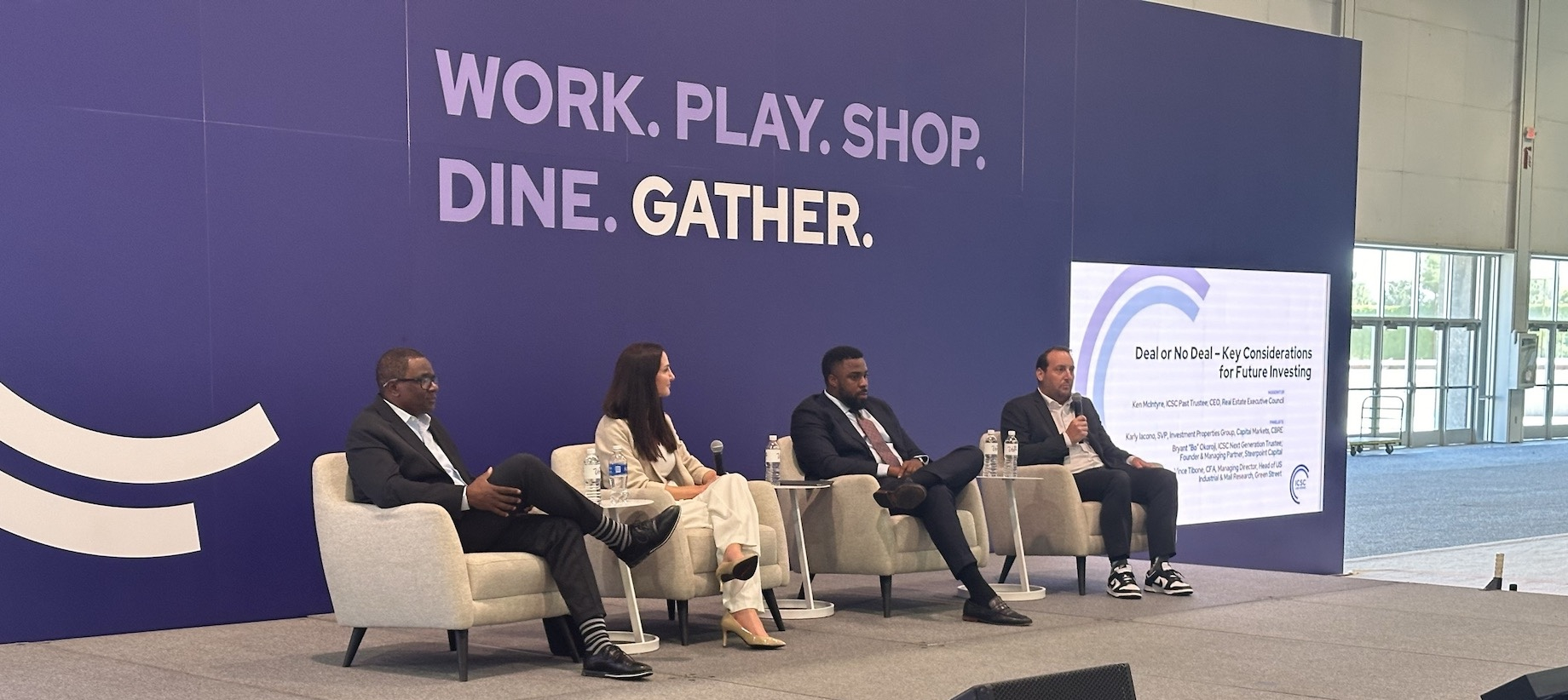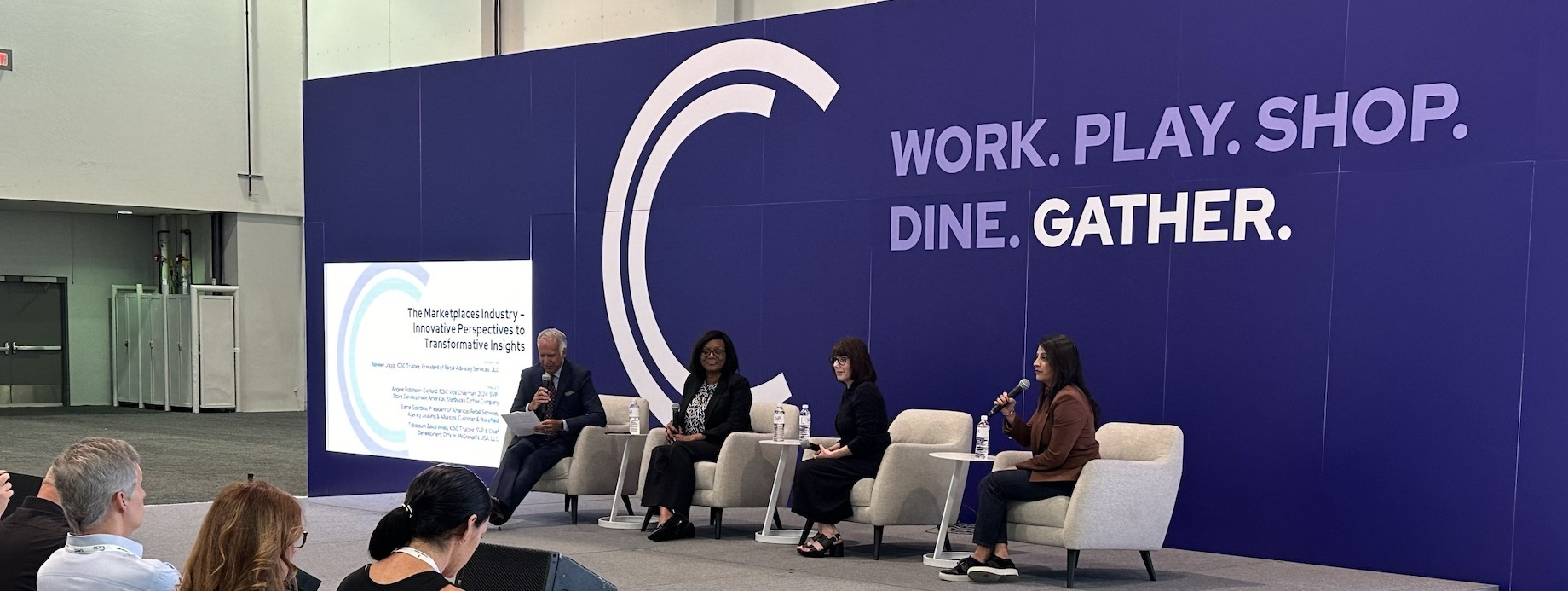Interest rates aren’t falling as fast as hoped, leading to a pricing standoff between retail property buyers and sellers. On the leasing side, landlords decidedly have the upper hand. These are some of the key takeaways from ICSC LAS VEGAS, where about 25,000 Marketplaces Industry professionals converged this week to make deals, tap trends and make connections. ICSC LAS VEGAS attendees are all about dealmaking, and legendary college football coach Nick Saban offered some hard-hitting motivation during his keynote speech, saying: “You’re only as good as your last play.”
Retail Is Savoring Its New Status as the Favored Sector
A wave of institutional capital is waiting on the sidelines to deploy into retail from other commercial property sectors whose fundamentals are weaker, according to execs at the event. More than 80% of the U.S. retail properties that traded in 2023 went to private buyers, but that figure will decline to 65% to 75% this year as institutional capital reemerges into the retail space, according to JLL U.S. Retail Capital Markets senior managing director and co-leader Chris Angelone. “Investors are going from retail curious to retail serious,” he said. JLL retail property management president Kristin Mueller said hiring demand for retail asset managers is huge right now, indicating that institutional capital is ready to deploy in the sector. Many asset managers had moved to other sectors that institutional capital had been favoring.
And 1031 exchange investors are coming out of multifamily deals and want to reinvest that capital into retail, said CBRE senior vice president of investment properties and capital markets Karly Iacono.
Retail property investors of all types have more appetite for risk than in past years and are seeking value-add opportunities, she added. “There’s been an inversion of investor demand. They want short-lease, lower-credit tenants, high vacancy, a good center that’s been mismanaged.”

Real Estate Executive Council’s Ken McIntyre, CBRE’s Karly Iacono, Steerpoint Capital’s Bo Okoroji and Green Street’s Vince Tibone speaking at ICSC LAS VEGAS on the topic Deal or No Deal – Key Considerations for Future Investing.
Who’ll Blink First? Buyers and Sellers Face Tough Negotiations
Despite the strong investor interest in the Marketplaces industry, few deals are happening, as stubborn sellers and cost-of-capital-shy buyers wait for the Federal Reserve to lower interest rates. “People want 30% returns, and they’re waiting for them,” said DJM Capital CFO Charlie O’Connell. “Rate cuts will happen, but its pretend-and-extend until 2025.”
“There’s not going to be a rapid decline in interest rates, so we have to figure out how to buy new properties and hold on to the ones we have under the new normal,” said RedSwan CRE founder and CEO Edward Nwokedi. “Now is the time to eliminate variable-rate debt, raise more preferred equity to clean up [your] balance sheet.” RedSwan uses blockchain technology to tokenize equity stakes in commercial properties for sale to investors as securities, a unique finance tool available to owners that need liquidity.
For properties that aren’t making money, owners face a dilemma: Hold because of the interest rate or sell it for a loss. If they do sell, these owners must resort to seller financing or must find all-cash buyers. “The cost of capital is going up faster than rent, properties are losing value and there’s not a clear exit,” said Iacono. Smart owners are making the best of the situation by juicing the existing property’s income as much as possible, she said. Her clients are adding income via electric vehicle chargers, cell towers and adding outparcels.
Cities Can Help the Capital Stack
Cities can provide help to get tricky development projects across the finish line. As empty big-box stores get redeveloped into outdoor and entertainment space, city funds might be available to bridge the gap, said Peggy Blanchard, economic development specialist for the village of Algonquin, Illinois. C-PACE financing can add more equity to the capital stack of redevelopments that aren’t fully funded, said KeyBanc Capital Markets managing director and public finance Jeffrey Rink. Such loans can make up as much as 3% of a project’s total funding, he said. “Go to cities for help plugging a capital stack piece,” he said. “If you don’t ask, they’re never going to offer it.” He advised developers to consult local lenders for connections to local government officials who will champion projects. He cited Tulsa, Oklahoma, as a city whose government has “progressively and pragmatically” used financial tools to help transformative developments succeed.
Mall Makeovers Are Today’s Most Actionable Investment Play
The most actionable investment play right now is to buy a mall for redevelopment, said Tibone. “We have a lot of good malls with bad capital structure,” he said. “There aren’t enough third parties to seize the opportunity to buy these malls when they become available.” Steerpoint Capital founder and managing partner Bo Okoroji is one of those investors looking for enclosed malls to redevelop. His firm has purchased some $600 million worth. “There’s mispriced risk there,” he said. Ground-up development for mall parking lots is also one of the biggest opportunities for high return, he said. “Public REITs are selling malls, but banks are still holding their books.”
Tenants Are Paying Top Dollar for Growth
“Landlords are calling the shots now,” and tenants are willing to absorb the rent hikes to be in the top locations, said JLL America president of retail advisory services Naveen Jaggi. “They don’t pay the rent, they don’t get the space.”
Though the U.S. still faces an oversupply of existing retail space in general, there’s a dire shortage in the areas where retailers want to expand, allowing market rents to climb. “It’s a landlord’s market. There’s so little space,” said Barrie Scardina, Cushman & Wakefield president of Americas retail services, agency leasing and alliances.
Even so, many retailers feel a squeeze as inflation bites into their sales, said Bersani Strategies president James Bersani. “Volumes aren’t growing at the same ratio as rents and taxes,” he said, bemoaning occupancy costs of 14 to 16%. “Businesses need to have some room to profit.”

JLL’s Naveen Jaggi, Starbucks’ Angele Robinson-Gaylord, Cushman & Wakefield’s Barrie Scardina and Tabassum Zalotrawala speak on The Marketplaces Industry – Innovative Perspectives to Transformative Insights at ICSC LAS VEGAS.
McDonald’s is in major expansion mode, but it’s so hard to find suitable space, said senior vice president and chief development officer Tabassum Zalotrawala. “There’s a dearth of product,” she said. At certain properties, McDonald’s is asking some landlords to add endcap space with drive-thrus.
The fast-food chain has used artificial intelligence to determine 3,000 market gaps and is putting boots on the ground to evaluate those areas in person, she added. “We’re sitting down with landlords proactively and showing them where we’re going.”
Starbucks, meanwhile, is relocating some of its earliest stores, moving into more secondary and tertiary markets and developing an ecosystem of different stores and footprints for each market, said senior vice president of store development for the Americas Angele Robinson-Gaylord.
By Brannon Boswell
Executive Editor, Commerce + Communities Today